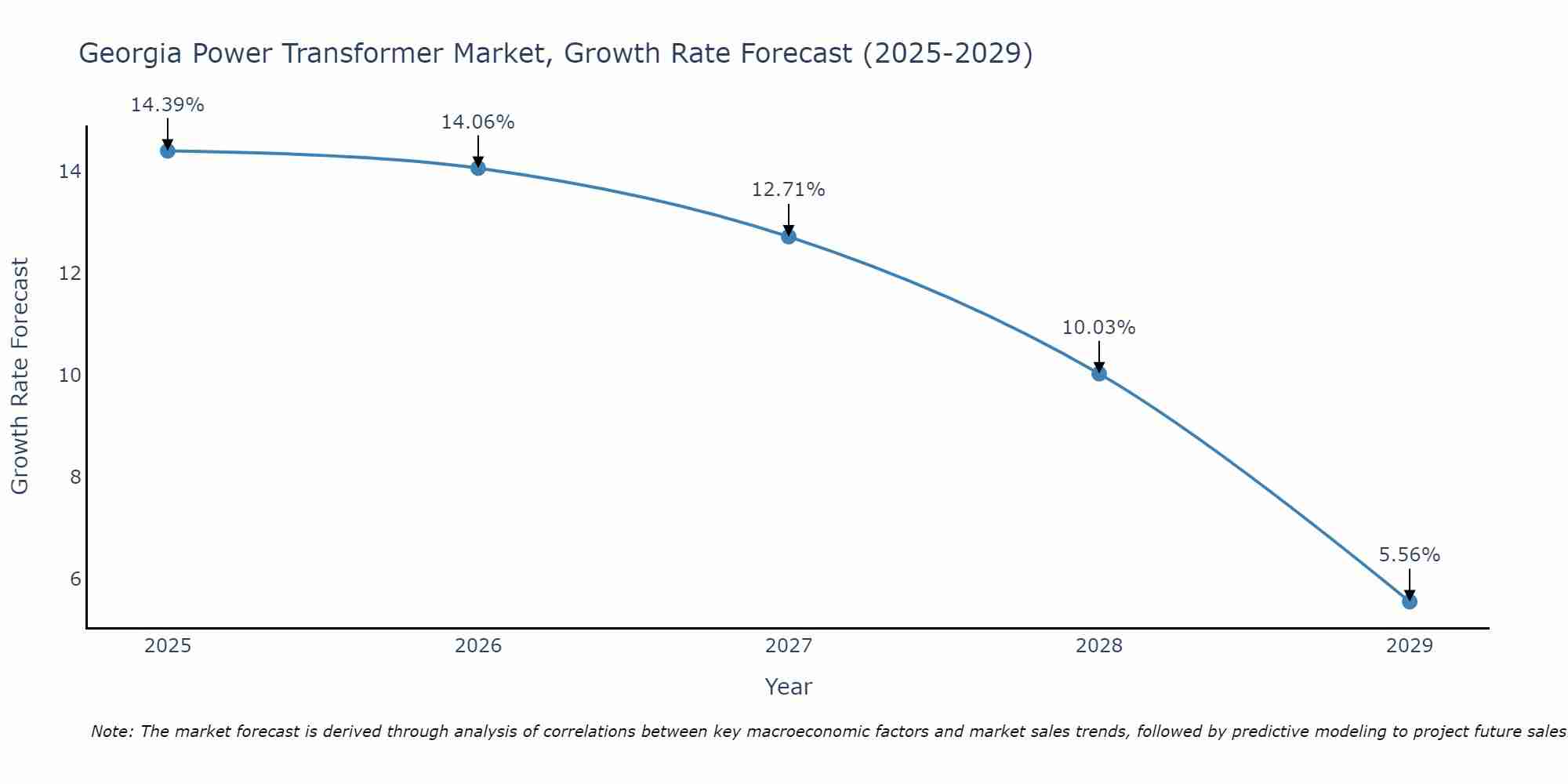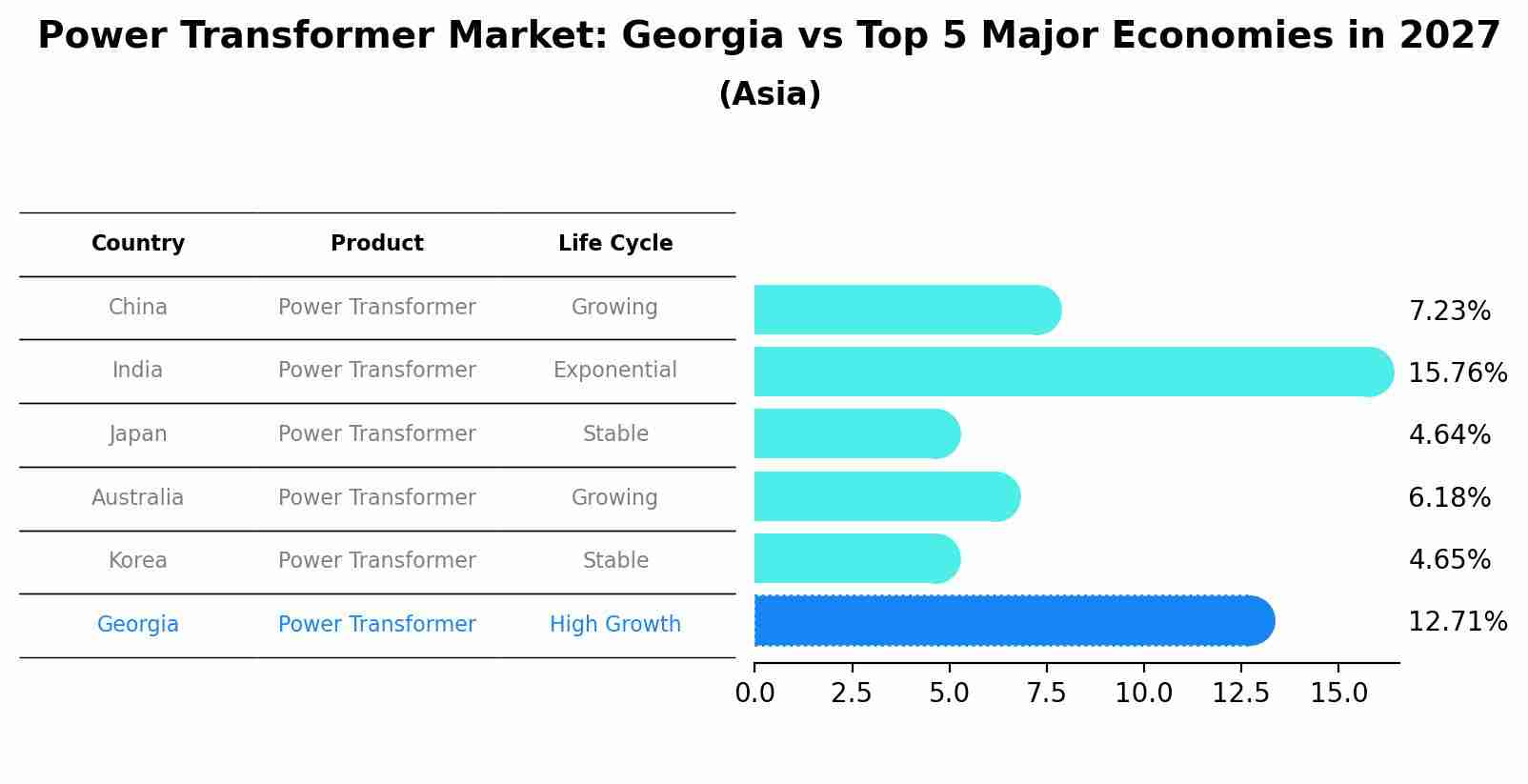Georgia Power Transformer Market Outlook | Growth, Share, Analysis, Size, Forecast, Value, Revenue, Trends, Companies, COVID-19 IMPACT & Industry
| Product Code: ETC268980 | Publication Date: Aug 2022 | Updated Date: Aug 2025 | Product Type: Market Research Report | |
| Publisher: 6Wresearch | Author: Ravi Bhandari | No. of Pages: 75 | No. of Figures: 35 | No. of Tables: 20 |
Georgia Power Transformer Market Size Growth Rate
The Georgia Power Transformer Market could see a tapering of growth rates over 2025 to 2029. Starting high at 14.39% in 2025, the market steadily declines to 5.56% by 2029.

Power Transformer Market: Georgia vs Top 5 Major Economies in 2027 (Asia)
By 2027, Georgia's Power Transformer market is forecasted to achieve a high growth rate of 12.71%, with China leading the Asia region, followed by India, Japan, Australia and South Korea.

Georgia Power Transformer Market Overview
In Georgia, the power transformer market is experiencing significant growth fueled by the expansion of electricity infrastructure and the increasing deployment of renewable energy sources. Power transformers are critical components that step up or step down voltage levels for transmission, distribution, and utilization of electrical energy. With increasing demand for electricity and integration of renewable energy, utilities and grid operators in Georgia are investing in transformer upgrades, replacements, and smart transformer technologies to enhance grid efficiency, reliability, and resilience, driving market growth and development in the region.
Drivers of the market
The power transformer market in Georgia is driven by several key factors contributing to its growth and development. One of the primary drivers is the increasing demand for electricity infrastructure upgrades and expansion to support economic growth, urbanization, and industrialization. With the aging of existing transformer infrastructure and the need to integrate renewable energy sources, there is a strong need for new transformers capable of meeting higher efficiency standards, accommodating higher voltage levels, and improving grid reliability. Additionally, the rise of smart grid technologies and the deployment of digital transformers are driving the adoption of advanced transformer solutions that can enhance grid monitoring, control, and automation capabilities. Moreover, the implementation of regulations and policies aimed at improving energy efficiency and reducing carbon emissions is further fueling market growth by incentivizing investments in energy-efficient and environmentally friendly transformer technologies in Georgia.
Challenges of the market
In the Georgia power transformer market, challenges stem from technological innovation, grid reliability, and environmental sustainability. Power transformers, essential for voltage conversion, transmission, and distribution, require efficiency improvements, reliability enhancements, and environmental considerations to meet evolving grid needs and regulatory requirements. Ensuring transformer reliability, longevity, and overload capability under varying load conditions and grid disturbances requires investment in transformer design, materials, and insulation technologies. Moreover, addressing concerns about transformer losses, noise levels, and environmental impact necessitates adoption of energy-efficient designs and environmentally friendly materials. Additionally, meeting diverse utility needs and grid requirements for transformer capacity, voltage regulation, and asset management requires customization and flexibility from transformer manufacturers. Furthermore, adapting to changing energy policies, market dynamics, and technological advancements requires strategic planning and collaboration between utilities, regulators, and stakeholders. Overcoming these challenges requires a holistic approach to transformer design, deployment, and operation that integrates reliability, efficiency, and environmental sustainability to ensure a resilient and sustainable power grid for the future.
Government Policy of the market
Georgia policies regarding the power transformer market prioritize reliability, efficiency, and environmental sustainability in electricity transmission and distribution. Regulatory frameworks govern transformer standards, performance requirements, and safety regulations to ensure the reliability and safety of transformer installations. The government supports initiatives to modernize transformer infrastructure, integrate advanced transformer technologies, and improve grid efficiency and resilience. By fostering collaboration between transformer manufacturers, utilities, and regulatory agencies, Georgia aims to enhance the competitiveness and sustainability of its power transformer market while meeting the growing demand for reliable and energy-efficient grid infrastructure.
Key Highlights of the Report:
- Georgia Power Transformer Market Outlook
- Market Size of Georgia Power Transformer Market, 2021
- Forecast of Georgia Power Transformer Market, 2028
- Historical Data and Forecast of Georgia Power Transformer Revenues & Volume for the Period 2018 - 2028
- Georgia Power Transformer Market Trend Evolution
- Georgia Power Transformer Market Drivers and Challenges
- Georgia Power Transformer Price Trends
- Georgia Power Transformer Porter's Five Forces
- Georgia Power Transformer Industry Life Cycle
- Historical Data and Forecast of Georgia Power Transformer Market Revenues & Volume By Rating for the Period 2018 - 2028
- Historical Data and Forecast of Georgia Power Transformer Market Revenues & Volume By Low (5 MVA to 100 MVA) for the Period 2018 - 2028
- Historical Data and Forecast of Georgia Power Transformer Market Revenues & Volume By Medium (100 MVA to 500 MVA) for the Period 2018 - 2028
- Historical Data and Forecast of Georgia Power Transformer Market Revenues & Volume By High (above 500 MVA) for the Period 2018 - 2028
- Georgia Power Transformer Import Export Trade Statistics
- Market Opportunity Assessment By Rating
- Georgia Power Transformer Top Companies Market Share
- Georgia Power Transformer Competitive Benchmarking By Technical and Operational Parameters
- Georgia Power Transformer Company Profiles
- Georgia Power Transformer Key Strategic Recommendations
Frequently Asked Questions About the Market Study (FAQs):
1 Executive Summary |
2 Introduction |
2.1 Key Highlights of the Report |
2.2 Report Description |
2.3 Market Scope & Segmentation |
2.4 Research Methodology |
2.5 Assumptions |
3 Georgia Power Transformer Market Overview |
3.1 Georgia Country Macro Economic Indicators |
3.2 Georgia Power Transformer Market Revenues & Volume, 2021 & 2028F |
3.3 Georgia Power Transformer Market - Industry Life Cycle |
3.4 Georgia Power Transformer Market - Porter's Five Forces |
3.5 Georgia Power Transformer Market Revenues & Volume Share, By Rating, 2021 & 2028F |
4 Georgia Power Transformer Market Dynamics |
4.1 Impact Analysis |
4.2 Market Drivers |
4.2.1 Increasing demand for electricity in Georgia |
4.2.2 Upgradation and modernization of existing power infrastructure |
4.2.3 Government initiatives to promote renewable energy sources |
4.3 Market Restraints |
4.3.1 Fluctuating raw material prices |
4.3.2 High initial investment costs for power transformer installations |
4.3.3 Environmental regulations impacting traditional transformer technologies |
5 Georgia Power Transformer Market Trends |
6 Georgia Power Transformer Market, By Types |
6.1 Georgia Power Transformer Market, By Rating |
6.1.1 Overview and Analysis |
6.1.2 Georgia Power Transformer Market Revenues & Volume, By Rating, 2018 - 2028F |
6.1.3 Georgia Power Transformer Market Revenues & Volume, By Low (5 MVA to 100 MVA), 2018 - 2028F |
6.1.4 Georgia Power Transformer Market Revenues & Volume, By Medium (100 MVA to 500 MVA), 2018 - 2028F |
6.1.5 Georgia Power Transformer Market Revenues & Volume, By High (above 500 MVA), 2018 - 2028F |
7 Georgia Power Transformer Market Import-Export Trade Statistics |
7.1 Georgia Power Transformer Market Export to Major Countries |
7.2 Georgia Power Transformer Market Imports from Major Countries |
8 Georgia Power Transformer Market Key Performance Indicators |
8.1 Average age of power transformers in Georgia |
8.2 Percentage of energy generated from renewable sources in the state |
8.3 Number of new power infrastructure projects initiated in Georgia |
9 Georgia Power Transformer Market - Opportunity Assessment |
9.1 Georgia Power Transformer Market Opportunity Assessment, By Rating, 2021 & 2028F |
10 Georgia Power Transformer Market - Competitive Landscape |
10.1 Georgia Power Transformer Market Revenue Share, By Companies, 2021 |
10.2 Georgia Power Transformer Market Competitive Benchmarking, By Operating and Technical Parameters |
11 Company Profiles |
12 Recommendations |
13 Disclaimer |
- Single User License$ 1,995
- Department License$ 2,400
- Site License$ 3,120
- Global License$ 3,795
Search
Thought Leadership and Analyst Meet
Our Clients
Related Reports
- Germany Breakfast Food Market (2026-2032) | Industry, Share, Growth, Size, Companies, Value, Analysis, Revenue, Trends, Forecast & Outlook
- Australia Briquette Market (2025-2031) | Growth, Size, Revenue, Forecast, Analysis, Trends, Value, Share, Industry & Companies
- Vietnam System Integrator Market (2025-2031) | Size, Companies, Analysis, Industry, Value, Forecast, Growth, Trends, Revenue & Share
- ASEAN and Thailand Brain Health Supplements Market (2025-2031) | Strategy, Consumer Insights, Analysis, Investment Trends, Opportunities, Growth, Size, Share, Industry, Revenue, Segments, Value, Segmentation, Supply, Forecast, Restraints, Outlook, Competition, Drivers, Trends, Demand, Pricing Analysis, Competitive, Strategic Insights, Companies, Challenges
- ASEAN Bearings Market (2025-2031) | Strategy, Consumer Insights, Analysis, Investment Trends, Opportunities, Growth, Size, Share, Industry, Revenue, Segments, Value, Segmentation, Supply, Forecast, Restraints, Outlook, Competition, Drivers, Trends, Demand, Pricing Analysis, Competitive, Strategic Insights, Companies, Challenges
- Europe Flooring Market (2025-2031) | Outlook, Share, Industry, Trends, Forecast, Companies, Revenue, Size, Analysis, Growth & Value
- Saudi Arabia Manlift Market (2025-2031) | Outlook, Size, Growth, Trends, Companies, Industry, Revenue, Value, Share, Forecast & Analysis
- Uganda Excavator, Crane, and Wheel Loaders Market (2025-2031) | Strategy, Consumer Insights, Analysis, Investment Trends, Opportunities, Growth, Size, Share, Industry, Revenue, Segments, Value, Segmentation, Supply, Forecast, Restraints, Outlook, Competition, Drivers, Trends, Demand, Pricing Analysis, Competitive, Strategic Insights, Companies, Challenges
- Rwanda Excavator, Crane, and Wheel Loaders Market (2025-2031) | Strategy, Consumer Insights, Analysis, Investment Trends, Opportunities, Growth, Size, Share, Industry, Revenue, Segments, Value, Segmentation, Supply, Forecast, Restraints, Outlook, Competition, Drivers, Trends, Demand, Pricing Analysis, Competitive, Strategic Insights, Companies, Challenges
- Kenya Excavator, Crane, and Wheel Loaders Market (2025-2031) | Strategy, Consumer Insights, Analysis, Investment Trends, Opportunities, Growth, Size, Share, Industry, Revenue, Segments, Value, Segmentation, Supply, Forecast, Restraints, Outlook, Competition, Drivers, Trends, Demand, Pricing Analysis, Competitive, Strategic Insights, Companies, Challenges
Industry Events and Analyst Meet
Whitepaper
- Middle East & Africa Commercial Security Market Click here to view more.
- Middle East & Africa Fire Safety Systems & Equipment Market Click here to view more.
- GCC Drone Market Click here to view more.
- Middle East Lighting Fixture Market Click here to view more.
- GCC Physical & Perimeter Security Market Click here to view more.
6WResearch In News
- Doha a strategic location for EV manufacturing hub: IPA Qatar
- Demand for luxury TVs surging in the GCC, says Samsung
- Empowering Growth: The Thriving Journey of Bangladesh’s Cable Industry
- Demand for luxury TVs surging in the GCC, says Samsung
- Video call with a traditional healer? Once unthinkable, it’s now common in South Africa
- Intelligent Buildings To Smooth GCC’s Path To Net Zero


















